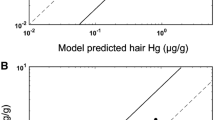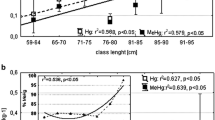Abstract
Hair, muscle, and liver mercury concentrations were determined in river otter (Lutra canadensis) carcasses collected from the lower coastal plain and piedmont of Georgia. Mean muscle and hair mercury concentrations were greater (P<0.001) in otters from the lower coastal plain (4.42 and 24.25 mg/kg wet wt, respectively) compared to otters from the piedmont (1.48 and 15.24 mg/kg, respectively). Liver tissue from lower coastal plain otters averaged 7.53 mg/kg mercury. Mean fetus brain and muscle mercury concentrations were 1.03 and 1.58 mg/kg wet wt, respectively, and fetal muscle mercury concentrations were correlated (r=0.92) with maternal muscle mercury concentrations. Comparison of mercury concentrations found in Georgia otters to those associated with adverse effects in otter and mink (Mustela vison), indicate sublethal contamination with concentrations in some individuals approaching that observed in experimentally dosed individuals that developed clinical signs of mercurialism. Mercury concentrations in fish from the lower coastal plain approached or exceeded concentrations demonstrated to be toxic to experimentally dosed otters.
Similar content being viewed by others
References
Aulerich RJ, Ringer RK, Iwamoto S (1974) Effects of dietary mercury on mink. Arch Environ Contam Toxicol 2:43–51
Beck DL (1977) Pesticide and heavy metal residues in Louisiana river otter. MS Thesis. Texas A&M University. College Station, TX, 95 pp
Borg K (1975) Den svenska fauman och miljogifterna. In: Symposier vid jubileet svensk veterinarmedicin 200 ar. Skara, pp 19–25
Borg K, Wanntorp H, Erne K, Hanko E (1966) Mercury poisoning in Swedish wildlife. J Appl Ecol 3:171–172
—, —, —, — (1969) Alkyl mercury poisoning in terrestrial Swedish wildlife. Viltrevy 6:301–379
Clark JD, Jenkins JH, Bush PB, Moser EB (1981) Pollution trends in river otter in Georgia. Proc Annu Conf Southeast Assoc Game Fish Comm 35:71–79
Cumbie PM (1975a) Mercury accumulation in wildlife in the Southeast. Ph.D. dissertation. University of Georgia, Athens, GA, 148 pp
— (1975b) Mercury levels in Georgia otter, mink and freshwater fish. Bull Environ Contam Toxicol 14:193–196
Cumbie PM, Jenkins JH (1974) Mercury accumulation in native mammals of the Southeast. Proc Annu Conf Southeast Assoc Game Fish Comm 28:639–648
Duplaix N, Simon N (1976) World guide to mammals. Crown Publishers, Inc, NY, 283 pp
Erlinge S (1972) The situation of the otter population in Sweden. Viltrevy 8:379–397
Fimreite N, Reynolds LM (1973) Mercury contamination of fish in northwestern Ontario. J Wildl Manage 37:62–68
Friley CE, Jr (1949) Age determination, by use of the baculum, in the river otter, Lutra c. canadensis Schreber. J Mammal 30:102–110
Georgia Water Quality Control Board (1971) Mercury pollution investigation in Georgia, 1970–1971, 110 pp
Halbrook RS, Jenkins JH, Bush PB, Seabolt ND (1981) Selected environmental contaminants in river otters (Lutra canadensis) of Georgia and their relationship to the possible decline of otters in North America. In: Chapman JA, Pursley D (eds). Worldwide furbearer conference proceedings. The Worldwide Furbearer Conference, Inc, Frostburg, MD, pp 1752–1762
Halbrook RS, Jenkins JH (1988) Cesium-137 levels detected in Georgia otters. Bull Environ Contam Toxicol 41:765–769
Hamilton WJ, Eadie WR (1964) Reproduction in the otter, Lutra canadensis. J Mammal 45:242–252
Hatch W, Ott W (1968) Determination of sub-microgram quantities of mercury in atomic absorption spectrophotometry. Anal Chem 40:2085–2087
Jenkins JH (1983) The status and management of the river otter (Lutra canadensis) in North America. Acta Zool Fennica 174:233–235
Jensen S, Johnels AG, Olsson M, Westermark T (1972) The avifauna of Sweden as indicators of environmental contamination with mercury and chlorinated hydrocarbons. Proc Int Ornitho Cong 15:455–464
Khera KS (1973) Reproductive capability of male rats and mice treated with methyl mercury. Toxicol Appl Pharmacol 24:167–177
Knudsen GJ, Hale JB (1968) Food habits of otters in the Great Lakes region. J Wildl Manage 32:89–93
Kreitzer JF, Heinz HG (1974) Effects of sublethal dosages of five pesticides and a polychlorinated biphenyl on avoidance response of coturnix quail chicks. Environ Pollut 6:21–29
Kurland LT (1973) An appraisal of the epidemiology and toxicology of alkylmercury compounds. In: Miller MW, Clarkson TW (eds). Mercury, mercurials, and mercaptans. Charles Thomas, Springfield, IL, pp 23–55
Lambou VW (1972) Problem of mercury emission into the environment of the United States. U.S. Environmental Protection Agency Report to the Working Party on Mercury, Sector Group on Unintended Occurrence of Chemicals in the Environment. OECD, Washington, DC, 81 pp
Lauhachinda V (1978) Life history of the river otter in Alabama with emphasis on food habits. PhD dissertation. Auburn Univ, Auburn, AL, 169 pp
Mason CF, Last NI, Macdonald SM (1986) Mercury, cadmium, and lead in British otters. Bull Environ Contam Toxicol 37:844–849
McDaniel JE (1963) Otter population study. Proc Annu Conf Southeast Assoc Game Fish Comm 17:163–167
Nelson N, Byerly TC, Kolbye AC, Kurland LT, Shapiro RE, Shibko SI, Strickel WH, Thompson JE, Van Den Berg LA, Weissler A (1971) Hazards of mercury. Environ Res 4:1–69
O'Connon, D.J., and S.W. Nielsen. 1981. Environmental survey of methylmercury levels in wild mink (Mustela vison) and otter (Lutra canadensis) from the Northeastern United States and experimental pathology of methylmercurialism in the otter. In: Chapman JA, Pursley D (eds.), Worldwide furbearer conference proceedings, Worldwide Furbearer Conference, Inc, Frostburg, MD, pp 1728–1745
Park E (1971) The world of the otter. JB Lippincott Co, NY, 159 pp
Pillay LKS, Thomas CC Jr, Sondel JA, Hyche CM (1972) Mercury pollution of Lake Erie ecosystem. Environ Res 5:172–181
Poole EL (1954) The otter—Pennsylvania's rarest furbearer. Penn Game News 25:4–9
Ropek RM, Neely RK (1993) Mercury levels in Michigan river otters, Lutra canadensis. J Freshwater Ecol 8:141–147
Sheffy TB, St. Amant JR (1982) Mercury burdens in furbearers in Wisconsin. J Wildl Manage 46:1117–1120
Spyker JM, Sparber SB, Goldberg AM (1972) Subtle consequences of methylmercury exposure: Behavioral deviations in offspring of treated mothers. Science 177:621–623
U.S. Environmental Protection Agency (1972) Mercury in fish (cold vapor technique). Washington, DC, 7 pp (mimeo)
Uthe J, Armstrong F, Stainton M (1970) Mercury determination in fish samples by wet digestion and flameless atomic absorption spectrophotometry. J Fish Res Board Can 27:805–811
Warren HW, Delavault RE, Barakso J (1966) Some observations on the geochemistry of mercury as applied to prospecting. Econ Geol 61:1010–1028
Wilson KA (1959) The otter in North Carolina. Proc. Southeastern Assoc Game Fish Comm 12:267–276
Windom HL, Taylor FE, Waiters EM (1975) Possible influence of atmospheric transport on the total mercury content of southeastern Atlantic Continental Shelf surface waters. Deep-Sea Res 22:629–633
Wobeser G, Nielsen NO, Schiefer B (1976) Mercury and mink II. Experimental methyl mercury intoxication. Can J Comp Med 40:34–45
Wobeser G, Swift M (1976) Mercury poisoning in a wild mink. J Wildl Dis 12:335:340
Wren CD (1985) Probable case of mercury poisoning in a wild otter, Lutra canadensis, in Northwestern Ontario. Can Field-Natural 99:112–114
Wren CD, Stokes PM, Fischer KL (1986) Mercury levels in Ontario mink and otter relative to food levels and environmental acidification. Can J Zool 64:2854–2859
Wrigley RE (1969) Ecological notes on the mammals of southern Quebec. Can Field-Nat 83:201–211
Author information
Authors and Affiliations
Rights and permissions
About this article
Cite this article
Halbrook, R.S., Jenkins, J.H., Bush, P.B. et al. Sublethal concentrations of mercury in river otters: Monitoring environmental contamination. Arch. Environ. Contam. Toxicol. 27, 306–310 (1994). https://doi.org/10.1007/BF00213164
Received:
Revised:
Issue Date:
DOI: https://doi.org/10.1007/BF00213164




